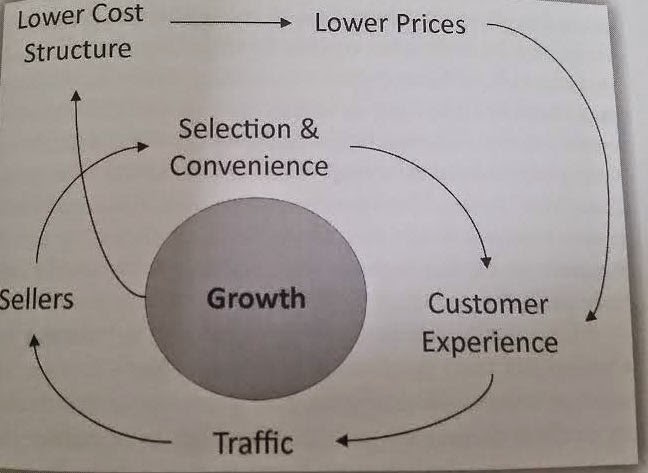Book review: The Amazon Way
I am reading the book "The Amazon Way, 14 leadership principles behind the wolrd's most disruptive company".
I am not going to write down all 14 principles, just buy the book if you are interested in that. The book is well written and you can read it in a few hours.
I just shortly summarize a few phrases from the book, that I find interesting.
Reading the book is a bit ambivalent, while when I was visiting Amazon in Germany, earlier this year, I did not recognize the open and innovative culture, the book describes.
However, the book is a motivator for anybody who is creative, customer centric and e-commerce and trend driven.
Long before the the complete vision of Amazon was ready, these two principles is where it all started from.
- When a company makes a customer unhappy, she won't tell a friend, or two, or three....she will tell many, many more and
- The beste customer service is "no" customer service, because the beste experience happens when the customer never has to ask for help at all.
For Jeff Bazos, the founder of Amazon, it is important not to focus at margin's. Focus at the "free cash flow". This is done because Jeff believes that the internet potential for growth is still enourmous. For him it is 1889.
 |
| The Amazon, flywheel effect (by the way also the only "picture"in the book |
The Andon cord is a concept , originally invented by a Japanese car manifacturer. So imagine if you work in a busy car plant and you notice that the widget you are installing is broken, you can reach up and pull the "Andon cord". Immediatly the whole assembly line stops. Amazon made a digital version of the Andon cord. When people in the retail group don't provide the right data for the customer or enter a product description that is inaccurate, the customer service department can remove the product from the website. "Fix the defect or you cannot sell this product". This is power to the consumer!
From a my personal experience, I think we could have used this method also a few times. If you think long term and about returning customers, this is a method that works very well.
The book has also many examples of social webcare. Methods that nowadays are used by many companies (but many still do not!!) Amazon was already pioneering with social webcare long before others did so. The book explains a situation where they noticed somewhere at the web, a customer experienced poor video playback, while watching a video via Amazon Video on Demand. Amazon pro-actively contacted the customer and refunded the amount.
Amazon does not do things "small", Amazon started by "scanning" the books they sold. This is very convenient for customers, so customers can browse a few pages of a book, before buying it. This was a very costly programm to setup and in that time took up a database of 20 terabytes. Amazon says "if we had tried it in a tentative way or at a small number of books, say 1000 or 2000, it would not have gotten the PR and full customers perception".
A nice sentence from the book -and so true- : if you are competitor focused, you have to wait until there is a competitor doing something. Being customer focused allows you to be more pioneering.
One of the biggest mistakes you can make at Amazon (as a leader) is sacrificing long term value for short term results.
You have to be open at Amazon. The highest level of customer service is impossible to achieve without a high degree of accountability and a willingness to be direct, open and honest.
Something that I personally value a lot and try to do as best as I can, (but this is difficult in many organisations) is that must never say "This is not my job". At Amazon, ownership means not only mastering your domain, but also willing to go beyond the boundaries of your role, whenever it is needed to improve customer experience or to solve a problem.
This really attracts me and I like to work this way, but from my personal experience, I know that at the same time this is so difficult in bureaucratic and political orientated organisations.
At Amazon they say: if you have something valuable to offer in regard to a specific program, you do not wait to be invited to the next meeting about that program, you simply show up! That's an enterpreneureal spirit and this helps employees to be motivated and customers to get the best experience!
Amazon.com continues to grow by inventing and simplifying every single day!
Another great phrase from the book! Process vs Bureaucracy.
An employee asked a question to Jeff Bazos. How about avoiding bureaucracy while still ensuring that certain rules were put in place. Jeff responded with : Good process is absolutely essential, without defined processes you cannot scale.you cannot put metrics and instrumentation in place, you cannot manage. But avoiding bureaucracy is essential. Jeff understood that A level performers hate bureaucracy and will leave organisations where it encroaches upon them. By contrast, C and D level performers, many of whom typically reside in middle management, love bureaucracy because they can hide behind it acting as gatekeepers and frequently creating the kind of friction that can bog down an entire company.
If you double the number of experiments you do per year, you are going to double your inventiveness. :) is what Jeff regularly says.
One of the 14 leaderships principles is "earning the trust of others". There are six keys to earning trust.
1) Open your kimono: learn to take accountability and admint faults. Not recklessly or in a way that let's people exploit you, but rather in a way that demonstrates honesty, and pursuit of improvement. If you put up a wall around yourself, your team will too.
2) Take the hit: when bad things happen resist the temptatiion to point the finger. As leader of a team, you need to accept responsibility for both the good an dthe bad. If your team members see that you are willing to take the blame even for mistakes that are not directly your foult, they will start to let go of fear and begin to trust you.
3) Build op your team members: Whenever appropriate, make sure you praise your team members in front of their peers and superiors. Never try to take sole credit for something that your team did.
4) Ditch the leash: allow your team members freedom to explore new idea's and to be creative. If people feel they are micro managed, they stop to trust you.
5) Accept confrontation: Fighting is not good, but neither is a false agreement. If disagreement never occurs, this is a warning sign that your team is afraid of telling you the truth.
6) Find the value in each person: we all have weaknesses, but we also have strengths. Find what is unique in each individual and use that unique strength for the good of the team.
Amazon creates 2 pizza rules teams.to keep up with invention.
Well, that and much more in the excellent and easy to read book "The Amazon Way".
Reading these kind of books always makes me enthousiastic about creative and innovative working, with a customer centric approach that leads to repeated conversion.
If you think "out of the box" with the customer in mind and try to translate this to digital, to help digital media solve customer's problems or to use digital to add value, and to give customers an experience, than you are on the right track.
There is still so much to do and to invent!



Comments
Post a Comment